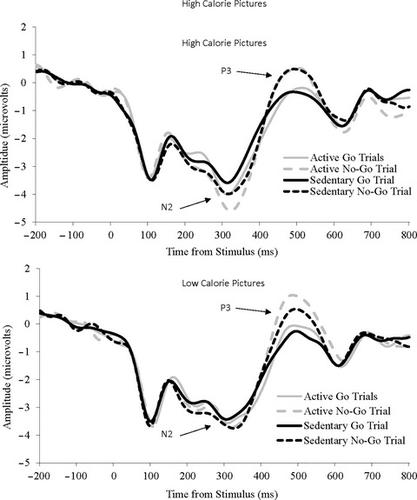当前位置:
X-MOL 学术
›
Eur. J. Neurosci.
›
论文详情
Our official English website, www.x-mol.net, welcomes your feedback! (Note: you will need to create a separate account there.)
To play or not to play? The relationship between active video game play and electrophysiological indices of food‐related inhibitory control in adolescents
European Journal of Neuroscience ( IF 3.698 ) Pub Date : 2020-12-01 , DOI: 10.1111/ejn.15071 Joshua L. Smith 1 , Kaylie A. Carbine 2 , Michael J. Larson 2, 3 , Larry A. Tucker 1 , William F. Christensen 4 , James D. LeCheminant 1 , Bruce W. Bailey 1
European Journal of Neuroscience ( IF 3.698 ) Pub Date : 2020-12-01 , DOI: 10.1111/ejn.15071 Joshua L. Smith 1 , Kaylie A. Carbine 2 , Michael J. Larson 2, 3 , Larry A. Tucker 1 , William F. Christensen 4 , James D. LeCheminant 1 , Bruce W. Bailey 1
Affiliation

|
Sedentary behaviors, such as computer use and sedentary video games, are barriers to physical activity, contribute to overweight and obesity among adolescents, and can adversely affect eating behaviors. Active video games may increase daily physical activity levels among adolescents and improve food‐related inhibitory control. We compared the effects of acute bouts of active and sedentary video gaming on event‐related potential (ERP) indices of food‐related inhibitory control, energy expenditure, and ad libitum eating. In a within‐subjects design, 59 adolescent participants (49% female, Mage = 13.29 ± 1.15) completed two separate counterbalanced, 60‐min long video gaming sessions separated by seven days. Immediately after, participants completed two go/no‐go tasks with high‐ and low‐calorie images and N2 and P3 ERP amplitudes were measured. Participants also completed a Stroop task and were given high‐ and low‐calorie snacks to consume ad libitum. Results indicated that active relative to sedentary video games significantly increased energy expenditure on multiple measures (e.g., METs, heart rate, kcals burned) and participants consumed more calories after the active compared to the sedentary video game session. N2 amplitudes were larger when participants inhibited to high‐ compared to low‐calorie foods, suggesting that high‐calorie foods necessitate increased the recruitment of inhibitory control resources; however, there were non‐significant differences for the N2 or P3 amplitudes, accuracy or response times, and Stroop performance between active versus sedentary video game sessions. Overall, sixty minutes of active video gaming increased energy expenditure and food consumption but did not significantly alter neural or behavioral measures of inhibitory control to food stimuli.
中文翻译:

玩还是不玩?视频游戏活动与青少年食物相关抑制控制的电生理指标之间的关系
久坐的行为,例如使用计算机和久坐的视频游戏,是身体活动的障碍,会导致青少年超重和肥胖,并可能对进食行为产生不利影响。活跃的电子游戏可能会增加青少年的日常体育活动水平,并改善与食物相关的抑制性控制。我们比较了经常活动和久坐的视频游戏对食物相关抑制控制,能量消耗和随意饮食的事件相关电位(ERP)指数的影响。在试内设计,59倍青春期的参与者(49%为女性,中号年龄 = 13.29±1.15)完成了两个独立的,平衡的60分钟长的视频游戏会话,间隔7天。之后,参与者立即完成了高/低热量图像的两项通过/不执行任务,并测量了N2和P3 ERP振幅。参与者还完成了Stroop任务,并获得了高热量和低热量的零食以随意消费。结果表明,相对于久坐的视频游戏而言,相对于久坐的视频游戏而言,积极活动显着增加了多种指标(例如,MET,心率,千卡燃烧)的能量消耗,并且参与者在久坐后消耗的卡路里更多。与低热量食物相比,参与者抑制高热量食物时的N2振幅更大,这表明高热量食物必须增加抑制控制资源的招募。然而,在活动视频和久坐视频游戏之间,N2或P3幅度,准确性或响应时间以及Stroop性能没有显着差异。总体而言,六十分钟的主动视频游戏增加了能量消耗和食物消耗,但并未显着改变抑制食物刺激的神经或行为措施。
更新日期:2020-12-01
中文翻译:

玩还是不玩?视频游戏活动与青少年食物相关抑制控制的电生理指标之间的关系
久坐的行为,例如使用计算机和久坐的视频游戏,是身体活动的障碍,会导致青少年超重和肥胖,并可能对进食行为产生不利影响。活跃的电子游戏可能会增加青少年的日常体育活动水平,并改善与食物相关的抑制性控制。我们比较了经常活动和久坐的视频游戏对食物相关抑制控制,能量消耗和随意饮食的事件相关电位(ERP)指数的影响。在试内设计,59倍青春期的参与者(49%为女性,中号年龄 = 13.29±1.15)完成了两个独立的,平衡的60分钟长的视频游戏会话,间隔7天。之后,参与者立即完成了高/低热量图像的两项通过/不执行任务,并测量了N2和P3 ERP振幅。参与者还完成了Stroop任务,并获得了高热量和低热量的零食以随意消费。结果表明,相对于久坐的视频游戏而言,相对于久坐的视频游戏而言,积极活动显着增加了多种指标(例如,MET,心率,千卡燃烧)的能量消耗,并且参与者在久坐后消耗的卡路里更多。与低热量食物相比,参与者抑制高热量食物时的N2振幅更大,这表明高热量食物必须增加抑制控制资源的招募。然而,在活动视频和久坐视频游戏之间,N2或P3幅度,准确性或响应时间以及Stroop性能没有显着差异。总体而言,六十分钟的主动视频游戏增加了能量消耗和食物消耗,但并未显着改变抑制食物刺激的神经或行为措施。



























 京公网安备 11010802027423号
京公网安备 11010802027423号